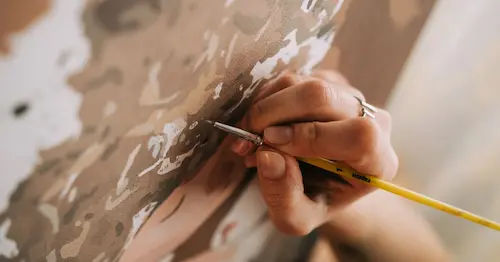Hi! Welcome to FunEmpire 👋
We take pride in finding the best local experiences, activities and services. We only recommend what we love, and hope you love them too. Learn about our story.
Acrylic Painting Singapore

Acrylic painting in Singapore unlocks a vibrant artistic gateway for both novices and skilled artists alike.
It’s a medium that blends ease of use with incredible versatility, catering to a wide range of creative expressions.
Across the island, numerous studios and workshops offer opportunities to learn and improve acrylic painting techniques.
This guide aims to explore the best places, tools, and tips for acrylic painting enthusiasts in Singapore.
Quick Summary
- Exploring Techniques and Styles: Discover various creative approaches and artistic styles in acrylic painting.
- Types of Acrylic Paint: Learn about different types of acrylic paints available for your artistic endeavors.
- Caring for Acrylic Paintings: Find out how to properly care for and preserve your acrylic artworks for lasting beauty.
- Common Mistakes in Acrylic Painting: Identify and avoid common errors artists make when working with acrylics.
Getting Started with Acrylic Painting

To embark on your acrylic painting journey, you’ll need a few essential materials. Begin with a set of high-quality acrylics that offer a wide range of colors. Look for paints that have good pigmentation and lightfastness, ensuring that your artwork retains its vibrancy over time.
Acrylic brushes come in various shapes and sizes, so consider having a selection that includes flat brushes for broad strokes, round brushes for detail work, and filbert brushes for blending. Additionally, invest in a suitable canvas or painting surface, such as stretched canvas, canvas boards, or acrylic paper. Lastly, a palette or palette paper will be necessary for mixing colors.
Exploring Techniques and Styles

1. Brushwork
Experiment with different brushstrokes and application methods to create a range of effects in your acrylic paintings. From broad, sweeping strokes to delicate details, the type of brush and the pressure applied can significantly impact the texture and appearance of your artwork.
2. Layering
Build up layers of transparent or opaque paint to add depth and dimension to your acrylic paintings. This technique allows you to create a sense of space, enhance color intensity, and achieve intriguing visual effects by selectively revealing or concealing underlying layers.
3. Glazing
Apply thin, translucent layers of paint over previously dried layers to create a luminous, stained-glass effect. Glazing allows you to achieve subtle color shifts, increase the richness of hues, and add a sense of depth and luminosity to your acrylic paintings.
4. Texture Creation
Discover the tactile side of acrylic painting by adding texture. Techniques like impasto, texture gels, or incorporating materials onto the canvas create visual interest and evoke emotions in your paintings.
5. Styles
Acrylic painting provides various styles for artistic expression. Try abstract painting for free-form exploration of shapes, colors, and textures to convey emotions. Explore landscape painting to capture nature’s beauty with acrylics. Experiment with portraiture, still life, or a mix of styles to develop your artistic voice.
Acrylic Paint Grades

1. Student Quality Acrylic Paints
Student Grade acrylic paints are more cost-effective than professional grade paints since they utilize less expensive, lesser pure pigments rather than the pricey ones utilized by professionals. They also have greater quantities of additives and extenders.
2. Artist Quality Acrylic Paints
Artist grade acrylic paints contain few additives or extenders, making them more susceptible to fading. The more colors you add, the less vibrant they’ll be. Artist paints are known for emphasizing each color’s distinctiveness.
Acrylic Painting: Tips To Paint Vibrantly

- Use two cups of water: Have one cup of water to wash off the paint from your brush and another cup to wet your clean brush before painting. This ensures cleaner and brighter paint colors.
- Complementary colors: Colors opposite each other on the color wheel are complementary. When used side by side, warm and cool colors create a pleasing contrast. For example, blue with orange or yellow with purple.
- Mixing complementary colors: Mixing complementary colors can result in cloudy colors instead of vibrant ones. Complementary colors combine to create a color similar to black. Avoid randomly mixing complementary colors together.
- Biased primary colors: Primary colors (red, yellow, blue) are not pure but have biases toward other colors. Determine if your primary color leans towards another color. For example, a yellow leaning towards orange is a warm yellow, while one leaning towards green is a cool yellow.
- Mixing biased primary colors: To achieve clean colors, mix primary colors that lean towards the same secondary color. For instance, a cool blue and a cool yellow, both leaning towards green, will create a nice green when mixed. Similarly, a warm blue mixed with a cool red will result in a pleasing purple.
- Avoid mixing warm and warm: Mixing warm versions of primary colors may lead to muddy colors. Warm blue and warm yellow will produce a muddy green due to the inclusion of red (warm blue and yellow contain red).
By following these tips, you can achieve clearer and more vibrant colors in your acrylic paintings, avoiding cloudiness and muddiness in your mixes.
Common Mistakes in Acrylic Painting

1. Being Afraid to Make Mistakes
We get it. Our society doesn’t encourage accepting mistakes. To enhance your painting and create quality pieces, embrace risks. By exploring new techniques, your art will improve significantly. You’ll learn from experience and understand the cause and effect better for next time.
2. Colour Mixing
Beginners often fixate on having a vast array of colors. All you really need are blue, yellow, red, and white. Mix them up and you’ll get the hang of it. Experiment and see what happens – you might surprise yourself with the colors you create.
3. Colour mixing part 2
Avoid squirting large amounts of paint for mixing to prevent color mismatches. Start with a small amount of each color, beginning with the lighter shade. Gradually add the darker color until you achieve your desired shade. It’s easier to darken a color than to lighten it, hence the sequence.
4. Take your brushes out of the water
Do not leave your brushes in the water, as you will easily damage the brushes by causing fraying. Simply lay them out of the water and flat, so that the water does not ever drip all over the brush, spoiling the glue of the brush. Just a simple art tip to save your brushes if you are doing it all wrong.
5. Sufficient Paint or Water on your brush
If you’re low on paint and feeling lazy to mix more, using the remnants can lead to bumpy edges. You’ll keep running out of paint quickly, needing to reload after short strokes, affecting the desired outcome.
6. Blending mistakes
Blending softens brush strokes without fully mixing colors. Use only a few strokes to avoid creating mud or a paint ring. Keep it simple with gentle strokes.
Acrylic Painting Singapore
By integrating these practices and insights into your acrylic painting journey, you’re well on your way to creating more vivid, lasting, and expressive pieces.
Remember, the essence of art lies in exploration and expression!
If you want to read more interesting articles, follow the links below:
- Best Art Jamming Studios in Singapore (2025)
- Best Art Jamming Ideas In Singapore (2025)
- The Ultimate Guide to Art Jamming Singapore (2025)
- The Origins of Art Jamming (2025)
- Best Art Jamming Singapore Workshops (2025)
- A Beginner’s Guide to the Best Art Classes in Singapore (2025)
- Relaxing Effects of an Art Jamming Workshop (2025)
Frequently Asked Questions (FAQ)
If you have any questions about acrylic painting in Singapore, you can refer to the frequently asked questions (FAQ) about Acrylic Painting In Singapore below:
Can beginners with no prior art experience start their creative journey with an acrylic painting course?
Absolutely! Acrylic painting courses are designed to accommodate art enthusiasts at all levels, including those with no prior art experience. These courses often cover the basics of colour theory, composition, and techniques specific to acrylics—a water soluble, richly coloured medium. Beginning your creative journey with an acrylic course can provide a solid foundation in fine arts.
What are some acrylic painting ideas that help explore pictorial composition for art enthusiasts?
Art enthusiasts looking to explore pictorial composition can start with fundamental concepts like understanding light and shadow, experimenting with different perspectives, and playing with colour contrasts and harmonies. Acrylic painting ideas that enhance composition skills include still life, landscapes, abstract art, and portraiture. Engaging in art workshops can also offer guided opportunities to explore various composition techniques in a supportive environment.
How can joining art workshops benefit individuals seeking to improve their acrylic painting skills?
Joining art workshops provides a unique opportunity for individuals to dive deeper into the world of acrylic painting. These workshops offer hands-on experience with various techniques, such as blending, layering, and texturing, using acrylics. Participants can also learn about the richly coloured medium’s properties, including its fast-drying nature and versatility. Moreover, art workshops are a great way to connect with other art enthusiasts, share creative ideas, and receive feedback on your work, enhancing your overall creative journey.







